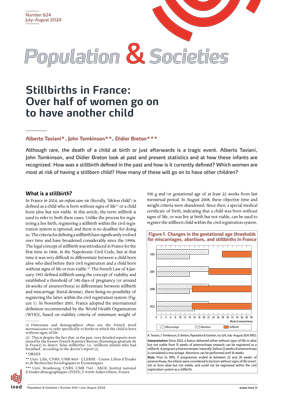Stillbirths in France: Over half of women go on to have another child
Press release Published on 19 August 2024
Population & Societies no. 624, July-August 2024

Authors: Alberto Taviani (DREES), John Tomkinson (CLERSE), Didier Breton (SAGE-INED)
The death of a child at birth or just afterwards is a tragic event. How has the definition of stillbirth in France changed and how have these infants been recognized over time? Which women are most at risk of having a stillborn child? How many of these will go on to have other children?
In France in 2024, an enfant sans vie (literally, ‘lifeless child’) is defined as a child who is born without signs of life or a child born alive but not viable. Today, a late miscarriage can be registered as a stillbirth at the discretion of the ‘parents’. A first name and surname can be given to the child, but no relationship of parentage.
The annual number of stillbirths is around 19 per 1,000 women, or slightly more than 10 stillbirths per 1,000 live births. This number has remained relatively stable in recent years, but it changed in the past due partly to changes in the definition over the last few decades.
Higher risk in early and late reproductive life
Around 1% of registered deliveries are stillbirths among women aged 20 to 40, but this proportion is higher at the beginning and end of reproductive life. Before age 18, it is between 1% and 2%. Near the end of reproductive life (around age 45), between 1.5% and 4.5% of registered births result in a stillbirth, depending on the period and definition. Besides maternal age and complications during birth, the mother’s health is also a determining factor. However, around 30% to 50% of stillbirths have no apparent explanation.
This study shows that this event does not mark the end of reproductive life. Over half of women go on to have another child within 5 years.
Outlook for the future
Declining neonatal mortality and falling fertility rates may lead to increasing individuation and personalization of the stillborn child by its ‘parents’, with greater demand for recognition both of the stillborn child and of parental status.
Over the longer term, demographic factors such as increasing age at childbirth and more frequent use of assisted reproduction could drive an increase in the number of stillbirths. Conversely, medical advances might lead to a reduction in the physiological risks associated with delivering a stillborn child and/or to the development of techniques for saving foetuses ‘expulsed’ before 5 months of pregnancy, resulting in a fall in the number of stillbirths alongside a corresponding fall in infant and neonatal mortality, the latter having stabilized since 2005.
Published on: 21/08/2024








